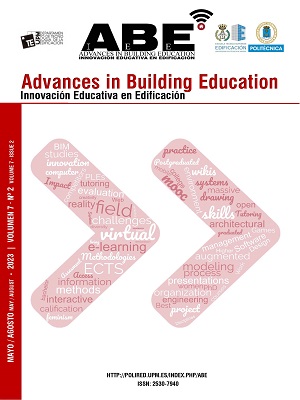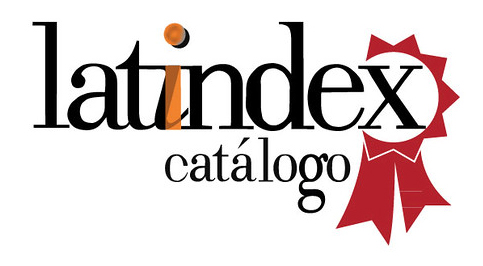Aprendiendo de la historia de la arquitectura mediante el análisis y modelado a escala de ejemplos arquitectónicos = Learning from architectural history through analysis and scale modeling of architectural examples
DOI:
https://doi.org/10.20868/abe.2023.2.5111Keywords:
arquitectura, elementos constructivos, modelado, historia, apuntes, architecture, constructive elements, modeling, history, notesAbstract
La asignatura de Historia y Teoría de la Arquitectura I, forma parte de la formación de los estudiantes de Arquitectura de la Universidad Técnica Particular de Loja, esta presenta un grado de complejidad para los estudiantes en su proceso de aprobación, debido a su contenido teórico y las clases transmitidas de manera unidireccional, lo que de alguna manera no está dando buenos resultados. Ante esto la propuesta se justifica por la necesidad de incorporar actividades alternativas que hagan que el alumno, relacione la teoría con la práctica, el resultado es un aporte didáctico, esta práctica se cumple a partir de varias actividades: la construcción a escala de diferentes elementos representativos de cada periodo de la historia, con base en redibujo de varias obras y detalles. Las conclusiones fueron un aprendizaje más efectivo y dinámico, comprobado por los resultados de aprendizaje, en comparación con otros parámetros de ciclos anteriores
Abstract
The subject of History and Theory of Architecture I is part of the formation of the students of Architecture of the Universidad Técnica Particular de Loja, this presents a degree of complexity for the students in their approval process, due to its theoretical content and the classes transmitted in a unidirectional way, which somehow is not giving good results. Given this, the proposal is justified by the need to incorporate alternative activities that make the student, relate theory with practice, the result is a didactic contribution, this practice is fulfilled from several activities: the construction to scale of different representative elements of each period of history, based on redrawing of various works and details. The conclusions were a more effective and dynamic learning, proven by the learning results, compared to other parameters of previous cycles
Downloads
References
M. V. V. Pérez, M. V. Castellanos, A. M. Díaz, J. A. González-Pienda, and J. C. Núñez, “Dificultades de aprendizaje en estudiantes universitarios de primer año,” Atenea (Concepción), no. 508, pp. 135–150, 2013, doi: 10.4067/S0718-04622013000200010.
C. Benítez, D. Gonda, and C. Pereira, “La historia desde la perspectiva de los alumnos del Bachillerato Diversificado,” Cuadernos de Investigación Educativa, vol. 1, no. 2, pp. 16–19, Mar. 2018, doi: 10.18861/CIED.1997.1.2.2811.
D. L. Prieto and F. A. P. Piñón, “La enseñanza de la historia en las aulas: un tema para reflexionar,” Debates por la Historia, vol. 9, no. 1, pp. 129–154, Jan. 2021, doi: 10.54167/DEBATES-POR-LA-HISTORIA.V9I1.629.
J. Colomer et al., “AYER Y HOY. DEBATES, HISTORIOGRAFÍA Y DIDÁCTICA DE LA HISTORIA,” 2015. Accessed: Mar. 19, 2023. [Online]. Available: https://roderic.uv.es/bitstream/handle/10550/42836/Libro%203_completo.pdf?sequence=2&isAllowed=y
R. A. Gaete Quezada, “El juego de roles como estrategia de evaluación de aprendizajes universitarios,” 2011, Accessed: Mar. 22, 2023. [Online]. Available: http://www.scielo.org.co/pdf/eded/v14n2/v14n2a04.pdf
P. Matía, E. Blanch, C. De la Cuadra, P. De Arriba, and J. L. De las Casas, Jose Gutiérrez, Conceptos fundamentales del lenguaje escultórico. Madrid: Ediciones Akal, S.A., 2006.
H. A. Millon and A. Fuster, “Las maquetas arquitectónicas en el Renacimiento,” DC. Revista de crítica arquitectónica, no. 15–16, pp. 23–28, 2006, Accessed: Mar. 12, 2023. [Online]. Available: https://upcommons.upc.edu/handle/2099/9401
Downloads
Published
Issue
Section
License
Copyright (c) 2023 Autor / BY-NC-ND

This work is licensed under a Creative Commons Attribution-NonCommercial-NoDerivatives 4.0 International License.
ABE (Advances in Building Education / Innovación Educativa en Edificación) does not charge authors for processing or publishing an article and provides immediate Open Access to its content. All content is available free of charge to the user or his institution. Users are permitted to read, download, copy, distribute, print, search or link to the full text of articles, or use them for any other lawful purpose, without prior permission from the publisher or author. This is in accordance with the BOAI definition of open access.
- Authors retain the copyright and grant to the journal the right to a Creative Commons attribution / Non-Commercial / Non-Derivative 4.0 International (CC BY NC ND) License that allows others to share the work with an acknowledgement of authorship and non-commercial use.
- Authors may separately establish additional agreements for the non-exclusive distribution of the version of the work published in the journal (for example, placing it in an institutional repository or publishing it in a book).
Unless otherwise indicated, all contents of the electronic edition are distributed under a Creative Commons license.














